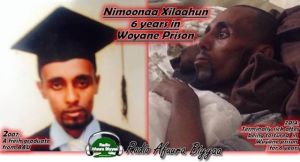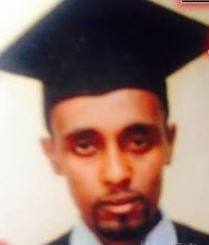By Bulbulaa Tufaa
Countries like Abyssinia, alias Ethiopia which has no root of any sense of democratic heritage, have been known for breeding despotic authoritarian institutions. The institutions, due to their inherent nature, cannot propagate the emergence of the very concept of the rule of people apart from the propagation of the rule of divine rulers. The recent massacre which has taken place under the absolute divine order of the Tigrian Ethiopian regime against peaceful Oromo student demonstration at Ambo, Gudar, Naqamtee, Haromyaa, DireDaawaa, Jimmaa, Baale Roobee, Mattuu etc. has been conducted pursuant to the divine rule of the ruler’s order. The massacre has been taking place according to the unadulterated form of early Atsewuyaan supreme primitive model of killing, mutilation and elimination, fitted to and influenced by early pristine situation of Negede Agaazian world of mutilation. The notorious Wayyaanee Ethiopian regime’s rapid deployment killing force known asAgaazii Xoor seems to have been derived from the Negede Agaazii, the ancestors of Atse Kalebawuyaan.
Taking into account the reality on the ground, such like, lack of socially charted institutions that can regulate Abyssinian societal behavioural tendencies in general, if at all the concept of “Peace” is believed to be born in this extremely ritualised non-conciliatory societies, it may take another ‘three thousand years’. The doctrine has been deeply rooted in incessant elimination of the peoples they call “aramanegalla”, meaning, according to their unique world perception, “infidels or savages”, who are surrounding the “civilised” tewahido island of Ethiopia.
As a colonised ethno-national, Oromo’s expectation of getting peace on their ancestral araddaa, specifically, as far as their children are being mutilated by the savage Agaazii Xoor, the question for “Selaamaawwii Tigil”, the rule of law, human dignity and veneration for ecosystem are dead. In the Abyssinian culture of power struggle, violence is ritualised as a pride of getting economic dominancy and a seizure of political power. If they come to power through far-fair casting ballots, the use of bullet as a last seal against the fair ballot would follow suit. The recent life bullets poured on Oromo peaceful demonstrators, against the written constitution of the regime, are a self-confirmation of the nature of Ethiopian rulers’ inherent cruelty, proliferated by the entrenched political thought of the society at large, not merely the unique political philosophy of the elites in power.
Theoretically, a dove may argue in favour of Abyssinians behavioural institutions, which could be democratised and with which a democratically arranged peaceful political polity could be restructured. But, the Abyssinians, as they are proud of it, have been living with their inflexible autocratic-authoritarian institution since 3000 years. This institution has shown no internal dynamism ever since. It continues to harbour Abyssinian secretiveness, aggressiveness and the culture of incessant violence in coming to power. They are neither ready to develop even an elementary form of a rule of law nor are they ready to accept other peoples’ democratically legislated laws.
As we had witnessed in the past decades, authoritarian-monarchism and dictatorial-socialism had been configured as alternative solutions for bringing peace to the needy peoples in the Empire. Both systems were dismantled by the use of firearms against each other by Abyssinian bullet mongers. Then, in 1991, federalism came as a conciliatory political solution. This time, since all the fake federal and regional structures are tightly controlled by elites from the old archaic institutions of Tigray, federalism as a solution is also melting down. In this fake federal system, Abyssinian tradition of bowing to the will of the divine rulers’ order and the implementation of the order continue to follow the earliest form of Abyssinian master-slave relationship. It is totally anti-conciliatory to the Gadaa Oromo egalitarian rule of law, human dignity, and reverence to natural habitat. In short, Abyssinian “carnivorous” institutions have been devouring Oromiyaa’s “herbivorous” institutions, particularly since Tayitu Buxul and Minilik Haile-Melekot came with the obnoxious “Addis Ababa” and destroyed the pastureland of Gullallee and dried up Burqaa Finfinnee.
How can proponents of “selaamaawwii Tigil” fix a middle ground with societies like the Oromo, Sidama, Hadiya etc., who are not historically part of the wretched social thought of the Abyssinians? Could not it be like a very futile attempt of bringing two opposing magnetic poles to zero gravity? Please, bear with the following social perception of the Abyssinians and ask yourself, how the Ethiopian Empire could be democratised when the rule of the Empire is guided by such type of rigid social thoughts like:
Sishoom yaal bellaa, sishaar yiqocewaal. One who does not loot when he is in power shall regret when comes out of it. This is exactly what the Tigrian Ethiopian regime is doing in Oromiyaa today.
Ye abbaatih beet sizerref, aabreh ziref: When your father’s house is looted (robbed) take part in it, let you not be an onlooker. This is what some renegade Oromo elites are doing in collaboration with the looting regime.
Inne kemotiku behuwaala serdoo aaybiqel aallech ahiyya: May the grass never grow after my death, says a donkey.
Bilaa baaleny innde abbaatee beqommexegn: If I were lucky to eat in peace, He (God) would make me suffer from leprosy.
Sewun maamen qabroonew. Trust a man only after you bury him.
Nugus aykesses, semaay aayittaares. As the sky cannot be ploughed, a king should not be indicted.
Abyssinian elite politicians, academicians, priests, peasants etc. are the aggregated product of the whole system of such kind social thought. They are not a detached figure who were born and grew up in a separate social incubator.
The Perilous Situation of Nagaa Oromoo
Under the devilship of Tigrian Ethiopian regime, war of massacre has been declared on the Oromos. Particularly, the recent massacre in Oromiyaa has severely damaged all venues of Nagaa Oromoo’seffortto forge any form of peaceful struggle, or peaceful dialogue as Ethiopians. The TPLF led Tigrian Ethiopian regime`s heinous massacre and its brutality have gone beyond extreme limits. What should Oromos do as a last option to get-heeled the endangered peace on their ancestral araddaa? Should they, from every walk of life, need to prepare themselves for the worst scenario to come ahead of them or not?. In our life time, we have seen the exhaustion of all venues of peaceful struggle and peaceful dialogue to solve the root cause of conflicts in the Ethiopian Empire. In order to get back their God-given natural right and the invaded ancestral homeland, self-sacrifice is found to be the only heroic price to be paid by every Oromo residing at home and abroad, as Oromo youths are paying right now.
Note that, all Ethiopian successive regimes emanated from those traditionally autocratic societies of the north, have never been the regimes for/of peace, even among themselves, leave alone to give peace to other peoples. To protect their interests in conquered regions of Oromiyaa, Gambella, Beneshangul, Sidamaa, Ogadenia etc., the only sustainable mechanism they need to use is the advancement of the doctrine of violence, deception, trickery, and mischief as codified in their book of guide, the Kibire Negest,that legitimises slavery and war as holy institutions.
Those Oromo groups, who have been preaching “democratisation”, rule of law, respect of human dignity, Ethiopia’s inviolable unity, peaceful struggle are kindly asked, before everything, to appeal to Abyssinian entrenched political and religious institutions to show an internal dynamism. Without having seen twilight of change in their deeply entrenched political thought, the demand for the birth of “democracy” as a healing wand was practically impossible in past and will not be possible in the future. It has been tried several times but consecutively aborted by successive murderous regimes of Ethiopia. Today, the politics of opposition parties’ “Selaamaawwii Tigil” is incarcerated, killed and mutilated by the incumbent Tigrian Ethiopian regime. It has bitterly damaged “Nagaa Oromoo”.Though the damage seems to have gone beyond recovery; it can be recovered to a full scale when full impetus is given by Oromos of all corners in unison. A very good sign is appearing.
Conclusion
Any nation, a tribe, a clan or a family does not willingly compromise on ceding its right of survival. They will unwillingly go to war to protect themselves against the serious harm targeting their right of survival on their homeland. The Tigrian Ethiopian regime of today has repeatedly shown how it is not a regime of peace, nor the regime of compromise. It is willingly forcing the Oromos to unwillingly go to war with its savage Agaazii Xoor.
The Ethiopian regime, currently led by Tigrian elites, has outrageously denied peaceful life, “Selaamaawwii nuuroo” and peaceful dialogue, “Selaamaawii wuyiyyiit” against the peoples in the Ethiopian Empire at large and the Oromo people in particular. By deploying its murderous Agaazii Xoor elsewhere, it is killing and butchering the people. It is terrorising them, inciting against each other, and denying them to live in peace with each other.
Hence, on one hand, Oromos’ struggle against the regime’s Agaazii Xoor, should focus on the rediscovery and recovery of the conquered path of “Nagaa Oromoo” in particular among themselves. On the other side, just as of now, Oromos should concentrate on how their concerted unity of action can speed up the demise of Abyssinian evil rulers’ coronation on their fathers’ araddaa, a sacred ancestor’s farmhouse, inherited by successive Oromo generations.
 Hiriyooti isaa akka ibsanitti, Nimoonaan akkuma maqaa isaa, yeroo mana barumsaa ture irraa kaasee haga gaafa hidhameetti, otuu garbummaa fi garboonfataaf hin jilbeeffatiin nama kutannoon qabsaa’aa tureedha.
Hiriyooti isaa akka ibsanitti, Nimoonaan akkuma maqaa isaa, yeroo mana barumsaa ture irraa kaasee haga gaafa hidhameetti, otuu garbummaa fi garboonfataaf hin jilbeeffatiin nama kutannoon qabsaa’aa tureedha.

